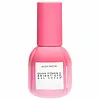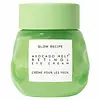What's inside
What's inside
 Key Ingredients
Key Ingredients

 Benefits
Benefits

 Concerns
Concerns

No concerns
 Ingredients Side-by-side
Ingredients Side-by-side

Water
Skin ConditioningCaprylic/Capric Triglyceride
MaskingGlycerin
HumectantNiacinamide
SmoothingBehenyl Alcohol
EmollientSorbitan Olivate
EmulsifyingCetearyl Olivate
Sodium Ascorbyl Phosphate
AntioxidantButylene Glycol
HumectantDiisostearyl Malate
EmollientTetrahexyldecyl Ascorbate
AntioxidantCetyl Palmitate
EmollientPsidium Guajava Fruit Extract
AstringentAmmonium Acryloyldimethyltaurate/Vp Copolymer
Simmondsia Chinensis Seed Oil
EmollientPsidium Guajava Seed Oil
Emollient3-O-Ethyl Ascorbic Acid
Skin ConditioningAscorbyl Glucoside
AntioxidantMagnesium Ascorbyl Phosphate
AntioxidantCaffeine
Skin ConditioningAcetyl Tetrapeptide-5
HumectantAcetyl Hexapeptide-8
HumectantSodium Hyaluronate
HumectantPolyglyceryl-10 Dioleate
EmulsifyingSorbitan Palmitate
EmulsifyingBatyl Alcohol
EmollientHydroxyacetophenone
AntioxidantCaprylyl Glycol
EmollientMelia Azadirachta Extract
Skin Conditioning1,2-Hexanediol
Skin ConditioningCitric Acid
BufferingPolyglyceryl-10 Dipalmitate
EmollientSodium Citrate
BufferingSodium Phytate
Tocopherol
AntioxidantFraxinus Excelsior Bark Extract
Skin ConditioningMoringa Oleifera Seed Oil
EmollientPhenoxyethanol
PreservativeDecyl Glucoside
CleansingLauryl Glucoside
CleansingPyrus Malus Fruit Extract
Skin ConditioningPotassium Citrate
BufferingSilanetriol
Musa Sapientum Fruit Extract
Skin ConditioningEthylhexylglycerin
Skin ConditioningPrunus Armeniaca Kernel Extract
Skin ConditioningPyrus Communis Fruit Extract
Skin ConditioningRubus Idaeus Fruit Extract
AstringentWater, Caprylic/Capric Triglyceride, Glycerin, Niacinamide, Behenyl Alcohol, Sorbitan Olivate, Cetearyl Olivate, Sodium Ascorbyl Phosphate, Butylene Glycol, Diisostearyl Malate, Tetrahexyldecyl Ascorbate, Cetyl Palmitate, Psidium Guajava Fruit Extract, Ammonium Acryloyldimethyltaurate/Vp Copolymer, Simmondsia Chinensis Seed Oil, Psidium Guajava Seed Oil, 3-O-Ethyl Ascorbic Acid, Ascorbyl Glucoside, Magnesium Ascorbyl Phosphate, Caffeine, Acetyl Tetrapeptide-5, Acetyl Hexapeptide-8, Sodium Hyaluronate, Polyglyceryl-10 Dioleate, Sorbitan Palmitate, Batyl Alcohol, Hydroxyacetophenone, Caprylyl Glycol, Melia Azadirachta Extract, 1,2-Hexanediol, Citric Acid, Polyglyceryl-10 Dipalmitate, Sodium Citrate, Sodium Phytate, Tocopherol, Fraxinus Excelsior Bark Extract, Moringa Oleifera Seed Oil, Phenoxyethanol, Decyl Glucoside, Lauryl Glucoside, Pyrus Malus Fruit Extract, Potassium Citrate, Silanetriol, Musa Sapientum Fruit Extract, Ethylhexylglycerin, Prunus Armeniaca Kernel Extract, Pyrus Communis Fruit Extract, Rubus Idaeus Fruit Extract
Water
Skin ConditioningGlycerin
HumectantPropanediol
SolventCetearyl Alcohol
EmollientGlyceryl Stearate
EmollientPersea Gratissima Oil
Skin ConditioningC9-12 Alkane
SolventStearic Acid
CleansingButyrospermum Parkii Butter
Skin ConditioningKaolin
AbrasiveSodium Lauroyl Glutamate
Persea Gratissima Fruit Extract
EmollientSqualane
EmollientNiacinamide
SmoothingEthylhexylglycerin
Skin ConditioningHexylresorcinol
AntimicrobialOryza Sativa Extract
AbsorbentTocopheryl Acetate
AntioxidantAloe Barbadensis Leaf Juice
Skin ConditioningCoffea Arabica Fruit Extract
AntioxidantHyaluronic Acid
HumectantEthylhexyl Palmitate
EmollientSodium Hyaluronate
HumectantRetinol
Skin ConditioningPei-10
Hydrated Silica
AbrasiveSodium Chloride
MaskingFructan
Skin ConditioningMaltodextrin
AbsorbentSpirulina Maxima Extract
SmoothingCI 75300
Cosmetic ColorantPotassium Chloride
Potassium Phosphate
BufferingButylene Glycol
HumectantSodium Phosphate
BufferingHydrogenated Starch Hydrolysate
HumectantMaltooligosyl Glucoside
Skin ConditioningArginine
MaskingSilica Dimethyl Silylate
EmollientSodium Dilauramidoglutamide Lysine
HumectantSodium Hydroxide
BufferingCitric Acid
BufferingCaprylyl Glycol
EmollientCarthamus Tinctorius Seed Extract
Skin ConditioningLavandula Angustifolia Flower/Leaf/Stem Extract
MaskingMalachite Extract
AntioxidantRosmarinus Officinalis Leaf Extract
AntimicrobialPPG-3 Benzyl Ether Myristate
EmollientPolyisobutene
Pvp
Emulsion StabilisingC13-15 Alkane
SolventAcrylates/C10-30 Alkyl Acrylate Crosspolymer
Emulsion StabilisingSodium Hydroxypropylsulfonate Laurylglucoside Crosspolymer
CleansingParfum
MaskingHexylene Glycol
EmulsifyingPotassium Sorbate
PreservativeSodium Benzoate
MaskingPhenoxyethanol
PreservativeWater, Glycerin, Propanediol, Cetearyl Alcohol, Glyceryl Stearate, Persea Gratissima Oil, C9-12 Alkane, Stearic Acid, Butyrospermum Parkii Butter, Kaolin, Sodium Lauroyl Glutamate, Persea Gratissima Fruit Extract, Squalane, Niacinamide, Ethylhexylglycerin, Hexylresorcinol, Oryza Sativa Extract, Tocopheryl Acetate, Aloe Barbadensis Leaf Juice, Coffea Arabica Fruit Extract, Hyaluronic Acid, Ethylhexyl Palmitate, Sodium Hyaluronate, Retinol, Pei-10, Hydrated Silica, Sodium Chloride, Fructan, Maltodextrin, Spirulina Maxima Extract, CI 75300, Potassium Chloride, Potassium Phosphate, Butylene Glycol, Sodium Phosphate, Hydrogenated Starch Hydrolysate, Maltooligosyl Glucoside, Arginine, Silica Dimethyl Silylate, Sodium Dilauramidoglutamide Lysine, Sodium Hydroxide, Citric Acid, Caprylyl Glycol, Carthamus Tinctorius Seed Extract, Lavandula Angustifolia Flower/Leaf/Stem Extract, Malachite Extract, Rosmarinus Officinalis Leaf Extract, PPG-3 Benzyl Ether Myristate, Polyisobutene, Pvp, C13-15 Alkane, Acrylates/C10-30 Alkyl Acrylate Crosspolymer, Sodium Hydroxypropylsulfonate Laurylglucoside Crosspolymer, Parfum, Hexylene Glycol, Potassium Sorbate, Sodium Benzoate, Phenoxyethanol
 Reviews
Reviews

Ingredients Explained
These ingredients are found in both products.
Ingredients higher up in an ingredient list are typically present in a larger amount.
Butylene Glycol (or BG) is used within cosmetic products for a few different reasons:
Overall, Butylene Glycol is a safe and well-rounded ingredient that works well with other ingredients.
Though this ingredient works well with most skin types, some people with sensitive skin may experience a reaction such as allergic rashes, closed comedones, or itchiness.
Learn more about Butylene GlycolCaprylyl Glycol is a humectant and emollient, meaning it attracts and preserves moisture.
It is a common ingredient in many products, especially those designed to hydrate skin. The primary benefits are retaining moisture, skin softening, and promoting a healthy skin barrier.
Though Caprylyl Glycol is an alcohol derived from fatty acids, it is not the kind that can dry out skin.
This ingredient is also used as a preservative to extend the life of products. It has slight antimicrobial properties.
Learn more about Caprylyl GlycolCitric Acid is an alpha hydroxy acid (AHA) naturally found in citrus fruits like oranges, lemons, and limes.
Like other AHAs, citric acid can exfoliate skin by breaking down the bonds that hold dead skin cells together. This helps reveal smoother and brighter skin underneath.
However, this exfoliating effect only happens at high concentrations (20%) which can be hard to find in cosmetic products.
Due to this, citric acid is usually included in small amounts as a pH adjuster. This helps keep products slightly more acidic and compatible with skin's natural pH.
In skincare formulas, citric acid can:
While it can provide some skin benefits, research shows lactic acid and glycolic acid are generally more effective and less irritating exfoliants.
Most citric acid used in skincare today is made by fermenting sugars (usually from molasses). This synthetic version is identical to the natural citrus form but easier to stabilize and use in formulations.
Read more about some other popular AHA's here:
Learn more about Citric AcidEthylhexylglycerin (we can't pronounce this either) is commonly used as a preservative and skin softener. It is derived from glyceryl.
You might see Ethylhexylglycerin often paired with other preservatives such as phenoxyethanol. Ethylhexylglycerin has been found to increase the effectiveness of these other preservatives.
Glycerin is already naturally found in your skin. It helps moisturize and protect your skin.
A study from 2016 found glycerin to be more effective as a humectant than AHAs and hyaluronic acid.
As a humectant, it helps the skin stay hydrated by pulling moisture to your skin. The low molecular weight of glycerin allows it to pull moisture into the deeper layers of your skin.
Hydrated skin improves your skin barrier; Your skin barrier helps protect against irritants and bacteria.
Glycerin has also been found to have antimicrobial and antiviral properties. Due to these properties, glycerin is often used in wound and burn treatments.
In cosmetics, glycerin is usually derived from plants such as soybean or palm. However, it can also be sourced from animals, such as tallow or animal fat.
This ingredient is organic, colorless, odorless, and non-toxic.
Glycerin is the name for this ingredient in American English. British English uses Glycerol/Glycerine.
Learn more about GlycerinNiacinamide is a multitasking form of vitamin B3 that strengthens the skin barrier, reduces pores and dark spots, regulates oil, and improves signs of aging.
And the best part? It's gentle and well-tolerated by most skin types, including sensitive and reactive skin.
You might have heard of "niacin flush", or the reddening of skin that causes itchiness. Niacinamide has not been found to cause this.
In very rare cases, some individuals may not be able to tolerate niacinamide at all or experience an allergic reaction to it.
If you are experiencing flaking, irritation, and dryness with this ingredient, be sure to double check all your products as this ingredient can be found in all categories of skincare.
When incorporating niacinamide into your routine, look out for concentration amounts. Typically, 5% niacinamide provides benefits such as fading dark spots. However, if you have sensitive skin, it is better to begin with a smaller concentration.
When you apply niacinamide to your skin, your body converts it into nicotinamide adenine dinucleotide (NAD). NAD is an essential coenzyme that is already found in your cells as "fuel" and powers countless biological processes.
In your skin, NAD helps repair cell damage, produce new healthy cells, support collagen production, strengthen the skin barrier, and fight environmental stressors (like UV and pollution).
Our natural NAD levels start to decline with age, leading to slower skin repair, visible aging, and a weaker skin barrier. By providing your skin niacinamide, you're recharging your skin's NAD levels. This leads to stronger, healthier, and younger looking skin.
Another name for vitamin B3 is nicotinamide. This vitamin is water-soluble and our bodies don't store it. We obtain Vitamin B3 from either food or skincare. Meat, fish, wheat, yeast, and leafy greens contain vitamin B3.
The type of niacinamide used in skincare is synthetically created.
Learn more about NiacinamidePhenoxyethanol is a preservative that has germicide, antimicrobial, and aromatic properties. Studies show that phenoxyethanol can prevent microbial growth. By itself, it has a scent that is similar to that of a rose.
It's often used in formulations along with Caprylyl Glycol to preserve the shelf life of products.
Sodium Hyaluronate is hyaluronic acid's salt form. It is commonly derived from the sodium salt of hyaluronic acid.
Like hyaluronic acid, it is great at holding water and acts as a humectant. This makes it a great skin hydrating ingredient.
Sodium Hyaluronate is naturally occurring in our bodies and is mostly found in eye fluid and joints.
These are some other common types of Hyaluronic Acid:
Learn more about Sodium HyaluronateWater. It's the most common cosmetic ingredient of all. You'll usually see it at the top of ingredient lists, meaning that it makes up the largest part of the product.
So why is it so popular? Water most often acts as a solvent - this means that it helps dissolve other ingredients into the formulation.
You'll also recognize water as that liquid we all need to stay alive. If you see this, drink a glass of water. Stay hydrated!
Learn more about Water